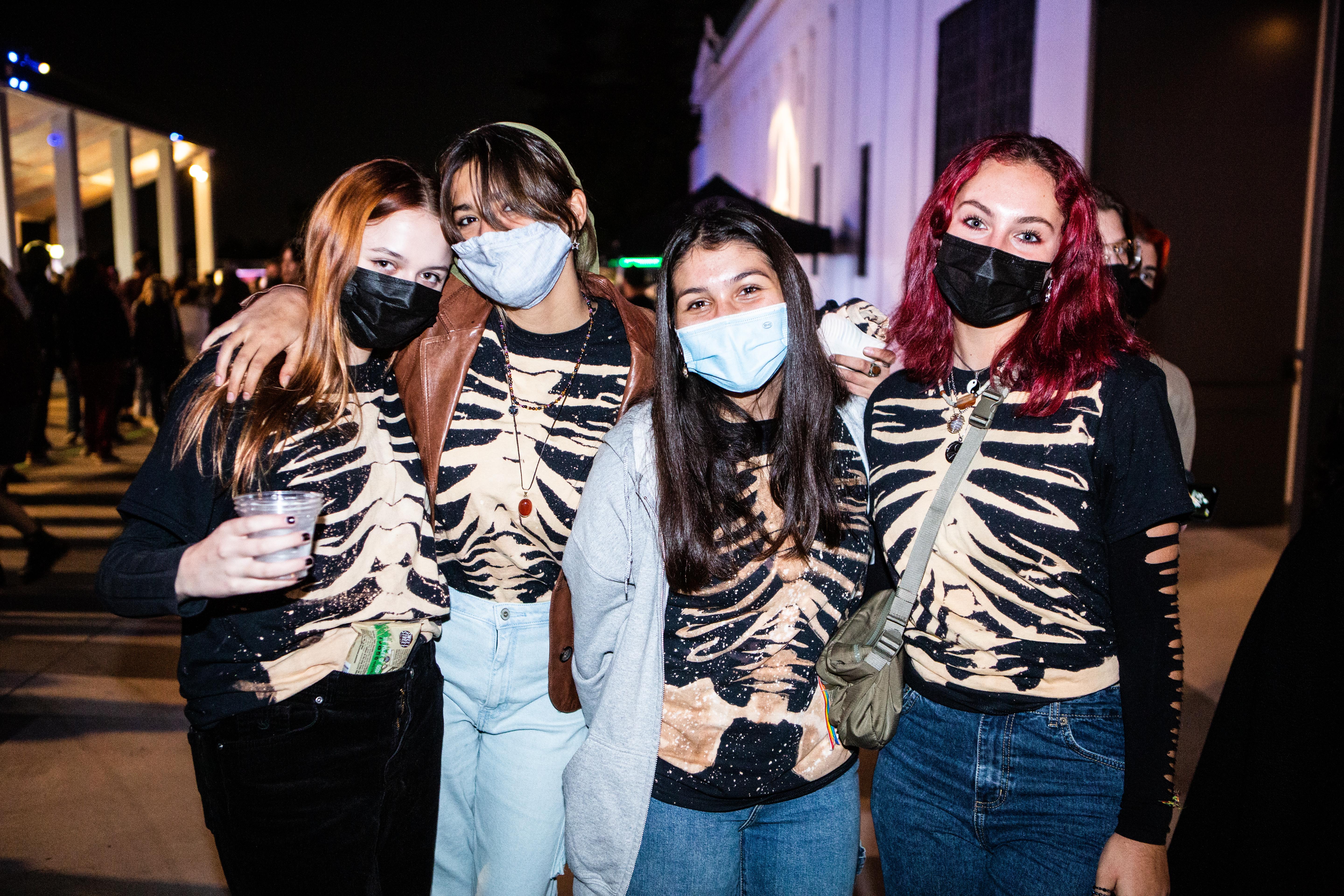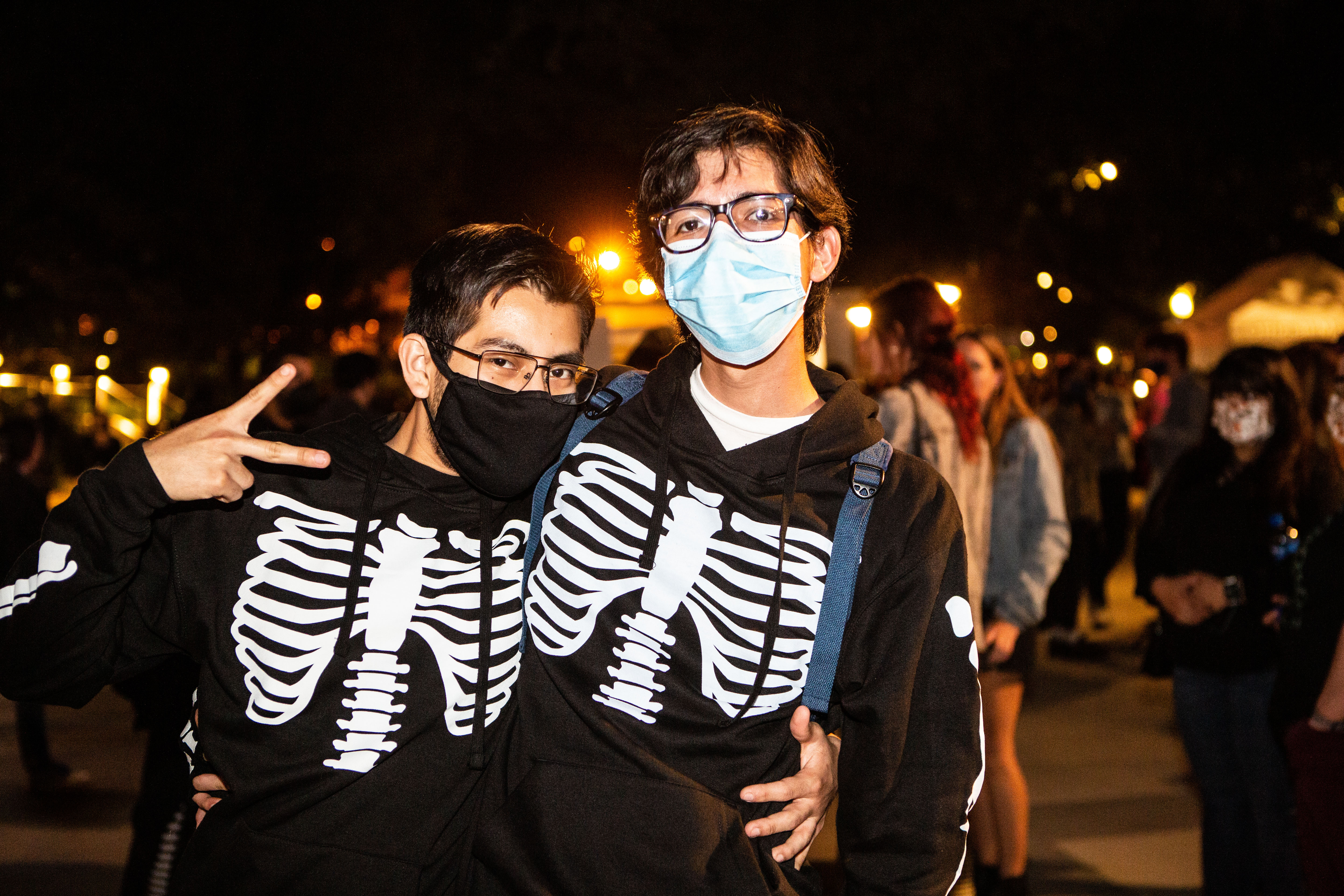The first thing I saw at Pitchfork Music Festival was a group of girls in skeleton costumes — the polyester onesie kind sold at Party City — sipping plastic cups of beer. Although music festivals tend to draw out whimsical fashions, I instantly knew who they were and why they were there, as they intended. They were fans of Phoebe Bridgers. And they were there to see Phoebe Bridgers.
The festival goers were, of course, dressed as Bridgers herself. The musician has made the skeleton suit her signature look since the release of her second album Punisher, the album of catchy, unprecious emo-folk songs that took her from an indie darling to superstar. On the cover, she wears the onesie, doused in red light, staring up at the stars. It’s a reference to the cover of her first album Stranger In The Alps, a baby picture of herself painted to look like a ghost, as well as her love of “corny, creepy stuff.”
The skeleton suit has become deeply embedded in Bridgers’ oeuvre. She’s worn and dressed her band in the costumes at most of their performance over the past two years, during which she’s accumulated a list of awards, TV appearances, viral tweets, and A-list collaborations so extensive that it would simply be easier for you to read about them in any of several dozen magazine profiles. She wore a Gucci rib cage on Saturday Night Live and a beaded Thom Browne bone gown on the Grammys red carpet. A pair of sweatpants with bones down the legs and Bridgers’ name printed on the butt, that fans enjoy posting themselves wearing with the caption “Phoebe Bridgers owns my ass,” are still sold out. It makes sense that fans are so obsessed with the ironic visual, which clicks into her world like a puzzle piece: turn your insides out, make a joke of it.
https://www.instagram.com/p/CLNJNqmB5fV/
Later that night, from my tiptoes at the flank of the crowd, I spotted several more pods of skeletons, gazing up at their anatomically incorrect leader and her band of cadavers. The sighting was nothing special. For Bridgers’ biggest fans, nicknamed “Pharbz,” attending her shows in skeleton costumes to match her has become a beloved ritual. Nearly every concert review of her ongoing tour makes a mention of onesie-d fans. On Reddit and meme groups, where fans document themselves at shows, skeleton ‘fit pics abound.
Watching the skeleton girls watch Bridgers, I was transported to the auditorium of Barclays Center, where I once watched KISS spit blood and shoot fire from their guitars to a sea of their doppelgangers. Since the 1970’s, the band’s fans, AKA the KISS Army, have made a ritual of imitating the band’s four members elaborate costumes, from their make-up to their platform boots, at their shows.
KISS is the most extreme, codified, and certainly the campiest example, but there’s a long tradition of fans cosplaying as favorite bands’ at their shows. In rock, these antics have been most aggressively sustained by the aging fanbase of classic rock and metal bands. To this day, devotees of Metallica and Iron Maiden wear their shirts to shows like sports jerseys, while a popular accessory for the latter’s include a mask of the band’s zombie mascot, “Eddie The Undead.” For other examples, look to Smashing Pumpkins’ “ZERO” T-shirt that became a fan staple in the ’90s after Billy Corgan began performing in the skateboard brand’s T-shirt or My Chemical Romance acolytes in military jackets.
It’s commonplace today for Beyoncé or Harry Styles’ fans to pay homage wearing costumes or merch to their shows. But unless you’re a metalhead, you rarely see this kind of full-throttle, fashion-forward display of fandom at rock shows anymore. Until recently, in the world of indie rock that Bridgers has emerged from, as critic Steven Hyden recently discussed in his “Ask a Music Critic” column, it’s been an unwritten rule that so much as wearing a band’s T-shirt to their show, let alone a head-to-toe costume imitating them, is lame.

People never stopped dressing up like rock stars. Strokes devotees may have well been in costume as Julian Casablancas, given the ubiquity in the ‘00s of his uniform of leather jacket, Converse, and skinny jeans. Or, take Vampire Weekend fans in cardigans of ambiguous irony. People who imitate musicians or artists are, if not signaling their musical allegiances, then articulating their identities by attempting to graft the qualities linked to these artists (in the case of the Strokes: youth, sex appeal, moody malaise; for Ezra Koenig: whimsicality, sensitivity, self-awareness) into their own image.
Something has broken with Bridgers, though. Theres’s a difference between wearing a leather jacket to try to look cool, and dressing in a silly costume in public to broadcast to other people that you’re an artist’s biggest fan. The kind of cosplay that Bridgers — and KISS and others before her — inspires is what happens when fans see the opportunity to participate in something that feels bigger than themselves. Right now, as Bridgers’ star rises higher than any other rock artist’s has in a long time, marking yourself as one of her tribe holds great appeal. It gives fans a way of carving out a place in her cultural moment.

Dressing up like Bridgers is about labeling yourself as a fan. But it also it’s a form of sartorial expression like any other outfit. The phenomenon suggests that there are fans who relate to Bridgers so intensely, they’re using her image as a shorthand for what they want to express about themselves, and can say more by doing so than by putting together their own ensemble. The skeletons are not just advertising that they love Bridgers’ music, but also that they share or at least identify with her everydude charm, morbid sense of humor, casual way of processing trauma, anxiety about the world, and view of life as full of both horror and possibility.
Of course, there is reason to be suspicious of the desire to subsume one’s identity within a celebrity’s. (And certainly to question how a band like KISS has turned their fans’ habit into a merchandising empire). Some will be less than thrilled to see stan antics, which famously can be deranged and even violent, blossoming in rock music. But fandom, at its best, is about a collective experience, in which artists become merely a shortcut to finding your people. Attending a show in costume, and knowing there’ll be others doing the same, can transform live music from entertainment to be consumed into a ritual of joyful belonging. At Bridgers’ shows, skeletons can spot their fellow cadavers across a crowd and know they understand without saying a word.







